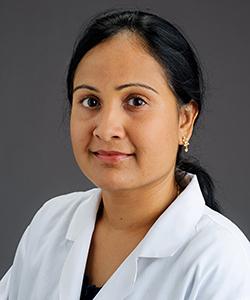Although October is Breast Cancer Awareness Month, women should be aware of breast cancer risk factors and warning signs year-round.
Puja Nistala, MD, a hematologist and medical oncologist at MU Health Care, explains risk factors, warning signs and steps you can take to reduce your risk.
How is breast cancer most often discovered?
Breast cancer most often is discovered through screening. We have a very successful screening program for breast cancers nationwide, and screening has been shown to be very effective. There are still some women who come in with interval cancers, which means they develop a lump in between screening tests. Those still happen, but they are rare. The most common discovery of breast cancer is still through screening tests.
What are the risk factors?
Older women are at a greater risk than younger women. In addition to age, family history and carrying a certain genetic mutation are the biggest risk factors. Women who undergo hormone therapy, especially if they have a family history of breast cancer or other risk factors, or chest radiation are also at increased risk. Other risk factors include obesity, alcohol consumption and smoking.
Are self-breast exams recommended?
Self-breast exams are recommended, especially in women who have history of breast cancer or a strong family history of breast cancer. Being familiar with the look and feel of your own breast tissue will help you know when to bring any changes to the attention of your primary care doctor.
What if you feel a lump?
Make an appointment with your primary care doctor, even if the lump is small. Your doctor can do a physical exam and refer you for imaging studies.
Is breast pain a sign of cancer?
Breast pain is not a common symptom of early breast cancer, a painless lump is a more common presentation. Your primary care doctor can help you figure out why you are experiencing pain.
What are some other signs of breast cancer?
It’s important to know the most common breast cancers do not cause any changes in skin appearance or texture. Some people may present with lumps in other areas, such as under their arms. Any abnormal or bloody nipple discharge can be a sign of cancer, especially if it comes from one nipple only. Some patients may just have redness on the breast, so any redness or wounds on the breast can be a sign, too.
At what age can age can women stop being screened for breast cancer
Age itself is a very soft guideline. It’s more about genetics and the general health of the patient. The guidelines among different organizations are slightly different, but all of them kind of agree that if you are older than 75 or have a life expectancy of less than 10 years, screening mammograms may not be very valuable. But even if you are 90, if you are healthy and have a life expectancy of 10 or more years, screening mammograms are still valuable.




